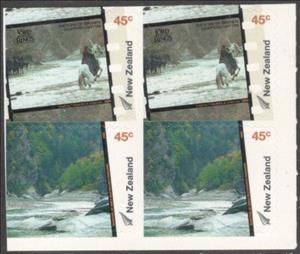Se-tenant: Skippers Canyon / The Ford of Bruinen - Sheet Block (New Zealand 2004)
Skippers Canyon / The Ford of Bruinen - Sheet Block (New Zealand 2004)
07 July (New Zealand ) within release Lord of the Rings (4th issue) - Home of Middle Earth goes into circulation Se-tenant Skippers Canyon / The Ford of Bruinen - Sheet Block face value 4*45 New Zealand cent
Se-tenant is horizontal format.
Se-tenant block of four from the self-adhesive sheet issue. The phosphor tag is on the right side over the value tablet. This shows pink under UV however the paper itself responds blue which is very evident in the selvedges. These have paper with vertical mesh so can be distinguished used.Also in the issue Lord of the Rings (4th issue) - Home of Middle Earth:
- Booklet - Lord of the Rings face value 6.30;
- Se-tenant - Mt Olympus & South of Rivendell face value 2*90;
- Se-tenant - Riding To Rohan - Erewhon face value 2*1.50;
- Se-tenant - Skippers Canyon & The Ford of Bruinen face value 2*45;
- Mini Sheet - The Lord of the Rings - Home of Middle Earth face value 270;
- Se-tenant - Tongariro - Frodo & Sam face value 2*2;
- Booklet Pane - Lord of the Rings (4th issue) booklet pane face value 6.30;
- Full Pane - New Zealand Home of Middle Earth, Limited Edition S/S face value 9.70;
- Se-tenant - Lord of the Rings - Home of Middle Earth face value 9.70;
- Se-tenant - Mt Olympus / South of Rivendell - Sheet Block face value 4*90;
- Se-tenant - Skippers Canyon / The Ford of Bruinen - Sheet Block face value 4*45;
- Se-tenant - South of Rivendell / Mt Olympus - Coil Join face value 4*45;
- Se-tenant - South of Rivendell / Mt Olympus - Coil Se-tenant face value 2*45;
Se-tenant Skippers Canyon / The Ford of Bruinen - Sheet Block it reflects the thematic directions:
A book is a medium for recording information in the form of writing or images. Books are typically composed of many pages, bound together and protected by a cover. Modern bound books were preceded by many other written mediums, such as the codex and the scroll. The book publishing process is the series of steps involved in their creation and dissemination.
The horse (Equus ferus caballus) is one of two extant subspecies of Equus ferus. It is an odd-toed ungulate mammal belonging to the taxonomic family Equidae. The horse has evolved over the past 45 to 55 million years from a small multi-toed creature, Eohippus, into the large, single-toed animal of today. Humans began to domesticate horses around 4000 BC, and their domestication is believed to have been widespread by 3000 BC. Horses in the subspecies caballus are domesticated, although some domesticated populations live in the wild as feral horses. These feral populations are not true wild horses, as this term is used to describe horses that have never been domesticated, such as the endangered Przewalski's horse, a separate subspecies, and the only remaining true wild horse. There is an extensive, specialized vocabulary used to describe equine-related concepts, covering everything from anatomy to life stages, size, colors, markings, breeds, locomotion, and behavior.
A landscape is the visible features of an area of land, its landforms and how they integrate with natural or man-made features. A landscape includes the physical elements of geophysically defined landforms such as (ice-capped) mountains, hills, water bodies such as rivers, lakes, ponds and the sea, living elements of land cover including indigenous vegetation, human elements including different forms of land use, buildings and structures, and transitory elements such as lighting and weather conditions. Combining both their physical origins and the cultural overlay of human presence, often created over millennia, landscapes reflect a living synthesis of people and place that is vital to local and national identity. The character of a landscape helps define the self-image of the people who inhabit it and a sense of place that differentiates one region from other regions. It is the dynamic backdrop to people’s lives. Landscape can be as varied as farmland, a landscape park, or wilderness. The earth has a vast range of landscapes, including the icy landscapes of polar regions, mountainous landscapes, vast arid desert landscapes, islands and coastal landscapes, densely forested or wooded landscapes including past boreal forests and tropical rainforests, and agricultural landscapes of temperate and tropical regions.
A film (British English) – also called a movie (American English), motion picture, moving picture, picture, photoplay or (slang) flick – is a work of visual art that simulates experiences and otherwise communicates ideas, stories, perceptions, feelings, beauty, or atmosphere through the use of moving images. These images are generally accompanied by sound and, more rarely, other sensory stimulations. The word "cinema", short for cinematography, is often used to refer to filmmaking and the film industry, and the art form that is the result of it. form that is the result of it.
A river is a natural freshwater stream that flows on land or inside caves towards another body of water at a lower elevation, such as an ocean, lake, or another river. A river may run dry before reaching the end of its course if it runs out of water, or only flow during certain seasons. Rivers are regulated by the water cycle, the processes by which water moves around the Earth. Water first enters rivers through precipitation, whether from rainfall, the runoff of water down a slope, the melting of glaciers or snow, or seepage from aquifers beneath the surface of the Earth.





